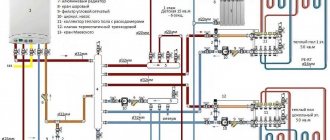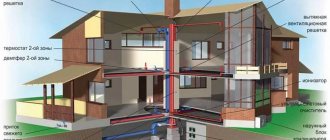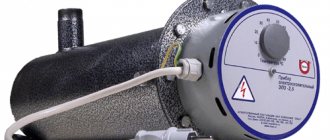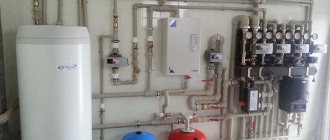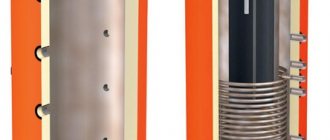The essence of geothermal energy is to use the natural heat of the earth at a depth of 1.5 m. This one of the alternative heating methods is actively used in industrial enterprises, rural farms, and residential buildings. The greatest effect is achieved in regions where the temperature drops below -20 degrees.
Most of our country, beyond the Urals in Siberia in the Far East, cannot boast of moderately cold winters like in the European part of Russia. Often the thermometer drops below -40 -45 degrees. Widely known and affordable air heat pumps in these conditions lose their relevance, since the most advanced models are able to effectively with a low-potential heat source with temperatures down to -20.
At the same time, soil and water covered with snow retain a large amount of heat. The ground temperature below the freezing point always remains positive +8 +12. In this situation, it is logical to abandon an easily accessible low-potential air source in favor of more stable and heat-intensive land and water.
It should also be noted that the efficiency of a heat pump, or rather its COP, directly depends on the temperature of the source. The warmer it is, the more efficient the energy conversion process.
What is geothermal energy?
Geothermal energy is the result of solar radiation. It accumulates in the ground. This low-grade heat can be used to heat residential buildings. The following can be used as a source of such energy:
- natural and technical reservoirs;
- waste heat;
- geothermal probes.
As you can see, geothermal heating of a house uses the natural heat of the planet.
The first systems of this type began to be used in the 70s of the last century. Now they are common in Western Europe, the USA, and Canada. For example, in Sweden the heat from the Baltic Sea is used to heat apartment buildings. Geothermal energy in our country is considered unconventional. The heat of the globe is considered to be an alternative source.
How to get heat into a house from the ground
The ground does not freeze completely even in winter. This feature is used by installation crews who lay the pipeline below the freezing point. Surprisingly, the temperature of these layers rarely drops below +5 +7°C degrees.
Is it possible to take advantage of the earth's ability to accumulate heat, extract it and use it to heat the coolant? Certainly! But in order to make alternative heating of a private house using earth heat possible, the following problems will need to be solved:
- Receiving heat - you will need to accumulate thermal energy and direct it to a storage tank.
- Heating the coolant. The heated antifreeze must transfer thermal energy to the liquid that circulates in the heating and hot water system.
- Cooled antifreeze must be returned to the heat exchanger for further heating.
To solve these issues, a geothermal pump using the heat of the earth was developed. A geothermal heat pump allows you to extract an amount of heat that is more than enough to produce a large amount of heat and use it as a main or additional heating equipment, depending on the design and location of the house.
Air manifolds
Underground heating of a private house can also be realized using air collectors. This is a simpler method of air heating in a private home compared to the previous two. To heat the air in a room to a comfortable temperature, a certain amount of heat is required. The lower the initial temperature, the higher the costs. With the help of a ventilation system and heat obtained from the ground, you can increase the air temperature in your home for free. Heating the earth with heat in this case is very simple. To organize a heating system you need:
- bring the ventilation air intake below the ground freezing level;
- lay a curved, straight or multi-pipe collector using ordinary sewer pipes (the shape is selected depending on the site, for every square meter of the house there should be 1.5 meters of collector);
- make an air vent at the end of the collector farthest from the house, bringing the pipe to a height of at least 1.5 meters from the ground and equipping it with a deflector umbrella (of course, the air flow into the house will be forced.
In this case, earth heating will not be able to fully provide the house with heat. However, it makes it possible to implement two ideas:
- The air entering through the ventilation can be heated with any heater (gas heat generator, solar, electric, etc.) and then distributed throughout the rooms using ventilation ducts. Such heating from the ground will not be completely free, but the costs will still decrease: it will not be the cold street air that will be heated, but the air that has already been warmed up to about +10 degrees. You can save money especially well if the winters in the region are cold.
- The air heated by the heat of the earth can be used to blow the external unit of a conventional air conditioner or air-to-air heat pump. Any device of this class can operate effectively at a temperature of about +10 degrees. The difficulty of implementation lies only in ensuring the required air flow. As a result, the air is heated by the heat of the soil, enters the heat pump and is discharged outside the house.
Heating with earth's heat is a good alternative to traditional heating methods, but at present it is not widespread (about
Composition of systems
A geothermal home heating system consists of a heat pump and a heat exchanger. In addition to them, this also includes a harmless and non-freezing liquid (antifreeze). It circulates through the circuit pipeline and collects the thermal energy accumulated in the ground. In heat pump evaporators, the energy of antifreeze is transferred to the refrigerant. As a result, it cools down by approximately 3 degrees.
Next, the temperature of the refrigerant is increased using a compressor. Thermal energy from this substance is transferred through a condenser to water circulating in the heating system of the house. It can also be used to heat domestic water in heat storage tanks.
The efficiency of such a system largely depends on the climate of the area. More precisely, it depends on the degree of warming of the earth. If the heat content in it is low, the building will not be able to heat. The soil temperature should not be lower than +5-+7 degrees. The most effective way is to connect to the “Warm Floor” system.
Geothermal pumps that use heat from the earth to heat a home
Heating using the energy of the earth occurs thanks to a special device - a geothermal pump. The principle of its operation is similar to a refrigerator:
- the gaseous refrigerant is compressed by the compressor, and at the same time becomes very hot;
- the refrigerant passes through the heat exchanger, giving off excess heat and cooling to room temperature;
- After cooling, this substance enters the cooling circuit of the freezer, where it then expands. As a result of a change in the state of aggregation from liquid to gaseous, the refrigerant cools sharply and cools everything around it;
- it then goes back to the compressor and the cycle repeats again.
Heating a house using earth energy occurs in a similar way. For example, a refrigerator takes heat from a cold object and transfers it to a warm object, thus transferring heat from a freezer with a sub-zero temperature to the room. The amount of pumped energy is several times greater than the electricity consumed by the compressor.
Heating from the heat of the earth is highly efficient - the thermal power is three times the amount of electricity consumed. If we compare a heat pump with a refrigerator, then in this case the soil, which has a constant temperature, replaces the freezer.
When creating a heating system, you need to install not only radiators to release heat, but also a heat exchanger on the second side of the circuit, which will take heat from the ground. There are two types of collectors:
- vertical;
- horizontal.
Before you start using heat from the ground to heat your home, you need to decide on the type of collector. You can see what they look like in the photo.
Principle of operation
The operating principle of geothermal heating is to collect heat from water or soil and transfer it to the building's heating system. Due to rising tariffs on traditional energy sources, this type of energy production is becoming popular in the Moscow region. During its arrangement, the surface of the earth performs the functions of an air conditioner in the summer and a heating source in the winter.
Thermal energy of the earth is collected using a special circuit or heat exchanger to collect heat. It is created from a pipeline and installed underground, in reservoirs or rocks. Installation methods may vary. The most common solution is vertically drilled wells. They are called geothermal. This option is possible even for small plots of land. It is considered more energy efficient compared to the horizontal circuit.
It is used in houses with a large plot. To install the collector, an excavator digs several trenches 2-2.5 meters deep. HDPE pipes are placed in the trench. The area of such a collector must be no less than the area of the house.
Used in small areas. Two wells, each 90 meters deep, are being drilled near the house. Geothermal probes are lowered into the well. Has high durability and greater efficiency.
If there is a reservoir of sufficient depth and size near your site, you can lower a horizontal collector to its bottom. This is the most energy efficient method of geothermal heating.
How does geothermal heating work?
As already noted, a geothermal heating system from the bowels of the earth is in many ways similar to the operation of an air conditioner in heating mode. What is happening at this moment?
- In the lower layers of the soil, at the bottom of a river or lake, water collectors are installed through which antifreeze circulates. Collectors absorb heat and release cold.
- The heated antifreeze rises to the top using a pump.
- Heat exchange occurs in the buffer tank. Heated antifreeze transfers thermal energy to the coolant or heats the water.
- The cooled antifreeze flows back to the collectors.
There are installations that are able to independently heat large rooms, others are used exclusively as auxiliary equipment capable of providing 50-75% of the room’s heat needs.
Operating principle
It was first published back in 1824 in France by the scientist Sadi Carnot. The effect of geothermal heating can be compared to an old type of refrigerator. In it, heat is removed through an exchanger outside the refrigerating chamber: as a result, the contents of the household appliance cool down. The geothermal method, on the contrary, forces the cold into the ground, and heat accumulates indoors.
According to the law of thermodynamics, heat from a heated body tends to transfer to a cold body and enter a state of equilibrium. Due to the expansion-evaporation of the refrigerant, its volume increases and the temperature decreases; the thermal energy of the earth tries to balance these processes. In contact with the ground, through the intermediate coolant, freon absorbs its heat. However, this is not enough to heat the building.
The system has three main components:
- Heat pump;
- a collector located underground;
- home heating system.
Features and installation procedure
The installation of geothermal heating in a private home should be entrusted to specialists. The main difficulties arise when installing the heat exchanger circuit in the ground. The main stages are the following:
1. Engineers visit the site. At the same time, they find out the features of the area and choose the most effective installation method.
2. Conclusion of an agreement and purchase of equipment.
3. Installation work. Heat exchangers are being installed in the ground. Then the geothermal installation is connected to the heating circuit of the building.
4. Commissioning works. After their completion, a certificate of delivery is signed.
The efficiency of the installation is influenced by the type of heat source. The most effective option is to install the heat exchanger circuit near a thermal source or at the bottom of a reservoir. The company installing the equipment may provide the customer with additional warranties. In accordance with current legislation, this is permitted subject to payment for such services. This will cost the customer an additional fee.
Installation and installation of geothermal heating
The main difficulty regarding the installation of geothermal equipment is associated with the installation of the heat exchanger circuit in the soil-ground. Although you can find a lot of advice on the Internet on how to do this work yourself, practice shows that most of the advice cannot be applied without special specialized education, therefore, all work must be performed by professional installers who are representatives of the manufacturer.
After contacting specialists, geothermal heating systems for private houses using the heat of the earth are installed in the following several stages:
- An engineer will visit your home. During the first visit, soil samples are taken, the features of the area are determined, and a decision is made on the most effective installation of the geothermal system. The efficiency of the installation can also be affected by the source of the intended heat. It is considered more productive to install heat exchangers at the bottom of a reservoir or at the sources of thermal sources.
- Concluding an agreement and purchasing the necessary equipment. Prices may vary significantly depending on the complexity of the installation work and other nuances. But on average, if a high-quality German manufacturer is chosen, the cost of installation will be approximately equal to its price. Turnkey purchase of Vaillant installation for a house of 350 sq. m. will cost approximately 21 thousand $
- Installation work. Heating a private house with underground geothermal heat sources, or rather, its efficiency largely depends on the correct implementation of work at the installation stage. After the water heat exchangers are installed in the ground, a connection is made to the geothermal installation and home heating system.
- Commissioning works. The engineer starts the system and makes fine adjustments to the device. After setup, the Work Completion Certificate is signed. According to current legislation, the company installing the equipment may provide additional warranties subject to payment for these services. Such guarantees will cost an additional $1000.
Installation
There are several ways to save a minimum of space for installing heat pumps:
- operation of underground probes. To do this, you will need to run a special circuit filled with antifreeze into a deep well;
- exploitation of warm groundwater. To do this, you will need to drill a fairly deep well. Groundwater is driven through a heat exchanger, previously pumped out by a pump;
- laying special umbrellas in a horizontal position below the level of winter glaciation at the bottom of the reservoir.
Benefits of Geothermal Heating
This type of system is an excellent way to supply heat to buildings. This is an opportunity to save money and energy. The main advantages of geothermal heating include:
- Energy efficiency
- A geothermal heating system generates 5 units of energy from 1 unit. The efficiency of such a system is 530%. The efficiency indicator of a modern gas boiler is 98%.
- Economic efficiency
- Due to the large difference in energy efficiency of such a system, on average, investments in it pay off in several years.
- Environmental Safety
Geothermal energy sources are recognized as the most environmentally friendly. They minimize the threat of air pollution. Installing one geothermal pump is the environmental equivalent of planting 750 trees.
- Fire safety
Since the heat pump does not use natural gas to operate, there is no source of flame or carbon monoxide.
- Everywhere Availability
The equipment can be installed anywhere. The main condition is the availability of electricity in the house.
- High reliability
The geothermal circuit is located underground at a constant temperature. It is not exposed to thermal loads during fuel combustion. The declared service life of heat pumps is 25-30 years.
Real advantages and disadvantages
If geothermal heating in the private sector has received relatively little distribution in Russia, does this mean that the idea is not worth the cost of its implementation? Maybe it’s not worth pursuing this issue? It turned out that this was not the case.
Using a geothermal heating system for your home is a profitable solution. And there are several reasons for this. These include the quick installation of equipment that can operate for a long time without any interruptions.
If you use high-quality antifreeze, rather than water, in the heating system, it will not freeze and its wear will be minimal.
We list other advantages of this type of heating.
- The fuel combustion procedure is excluded. We create an absolutely fireproof system, which, during its operation, cannot cause any damage to housing. In addition, a number of other issues related to the presence of fuel are eliminated: now there is no need to look for a place to store it, deal with its preparation or delivery.
- Significant economic benefit. During the operation of the system, no additional investments will be required. Annual heating is provided by the forces of nature, which we do not buy. Of course, when operating a heat pump, electrical energy is consumed, but the amount of energy produced significantly exceeds the amount of energy consumed.
- Environmental factor. Geothermal heating of a private country house is an environmentally friendly solution. The absence of a combustion process eliminates the release of combustion products into the atmosphere. If many people realize this, and such a heat supply system becomes widespread, the negative impact of people on nature will decrease many times over.
- Compactness of the system. You do not have to organize a separate boiler room in your home. All that is needed is a heat pump, which can be placed, for example, in the basement. The most voluminous contour of the system will be located underground or underwater; you will not see it on the surface of your site.
- Multifunctionality. The system can work both for heating in the cold season and for cooling during the summer heat. That is, in fact, it will replace not only your heater, but also your air conditioner.
- Acoustic comfort. The heat pump operates almost silently.
Choosing a geothermal heating system is cost-effective, despite the fact that you will have to spend money on the purchase and installation of equipment.
By the way, as a disadvantage of the system, they mention precisely the costs that will have to be incurred to install the system and prepare it for operation. You will need to buy the pump itself and some materials, and carry out work on installing the external manifold and internal circuit.
It is no secret that resources become more expensive year by year, so an autonomous heating system that can pay for itself within several years will always be economically beneficial for its owner
However, these costs pay off in just the first few years of operation. The subsequent use of a collector laid in the ground or submerged in water allows significant savings.
In addition, the installation process itself is not so complicated that it requires inviting third-party specialists to perform it. If you don’t do drilling, then you can do everything else yourself.
It should be noted that some craftsmen, in an effort to save money, have learned to assemble a geothermal heat pump with their own hands.
Disadvantages of geothermal heating:
- The cost of a geothermal method of heating a house will require significant capital costs.
- Volatility - the system requires power to operate. To avoid interruption of heat supply to your home due to a power outage, you need to purchase a gasoline or diesel fuel electric generator.
- Subcooling of the soil occurs in the area where the heat collection collector is located (usually due to errors made during the design). Leads to disruptions in the operation of the system.
Other heating system options
Today there are many different heating systems, but the heating system using liquid coolant has become the most widely used. Compared to other systems, it has the highest efficiency, practicality and safety. The principle of its operation is that the heat generator (boiler) heats water or non-freezing liquid (antifreeze), which flows through pipes into heating devices (radiators, convectors), heating them, which in turn heat the air in the room, and returns to its place heating
Methods for implementing a geothermal installation
This type of heating differs in the way the heat exchanger is installed. Today there are three varieties in use:
- Vertical heat exchanger: it is compact and has a higher installation cost compared to other types. To install a vertical heat exchanger, you do not need to use a large area, but you will need to use specialized drilling rigs. Depending on the chosen technology, the depth of the finished well can reach up to 200 meters, the minimum is 50 meters. The service life of the system is up to one hundred years. It is beneficial to install this type of geothermal heating if it is installed on an already developed area. The landscape of the area will remain virtually untouched.
- Horizontal heat exchanger: This type is used quite often. When installing a horizontal heat exchanger, the pipes are laid to a sufficiently large depth, which necessarily exceeds the level of soil freezing. The main disadvantage of using exactly this type of wiring is that it requires a large area to be used for installing the collector. It is difficult to install such a system on an already developed site.
- Water-based heat exchanger: this installation is the most cost-effective among all the variety of geothermal heating, as it works using the energy of water bodies. This system is relevant for those homeowners who have a body of water hundreds of meters away. Such a heat exchanger is the most profitable, which makes its installation the most appropriate among all types of similar heating.
Geothermal heating equipment
The implementation of a system of this type is only possible with special equipment. It accumulates heat from soil or water and transfers it to the coolant of the building’s heating system.
It includes:
- Heat pump;
- compressor;
- buffer tank;
- heat exchanger
The compressor helps bring the antifreeze to the required temperature. The buffer tank accumulates it after heating and transfers its heat to the coolant. The composition includes an internal tank, coolant water and a coil through which antifreeze circulates. This element is also necessary for the reason that the temperature of the antifreeze can vary from -5 to +20 degrees. At the same time, it expands and a container is needed to accommodate the increased volume.
Expenses
When manufacturing a 9 kW heat pump, you will have to spend:
- for condenser products and materials: $163;
- for evaporator: $206;
- for a used compressor and freon: about $50.
If you have automation, the total cost of a homemade heat pump will be approximately $500.
A polypropylene pipe PN10 with a diameter of 50 mm for the external circuit will cost 193 rubles. per linear meter.
Did you know that you can heat your house completely free of charge using the heat of the earth? Geothermal heating: principle of operation, advantages and disadvantages of technology.
We will discuss the operating principle of a heat pump for heating a house in this article.
Heat pumps
The main equipment of geothermal heating is a heat pump. It circulates antifreeze in the geothermal system. The heat pump controls the operation of the entire installation.
Spending 1 kW of electricity, it produces from 2.5 to 5 kW of thermal energy.
When heating residential buildings, cottages, municipal baths, and industrial facilities, pumps of different capacities are used.
In the case of using such systems for cottages, such a device completely solves the problems of hot water supply and heating. At industrial facilities, modular designs of heat pumps are used. In this case, standard modules with a heating capacity of 100 kW combine up to 25 units together.
Conclusion
The use of heat pumps allows you to get rid of traditional fuels that become more expensive every year, although the initial costs will be quite large. It is quite possible to install geothermal heating yourself, only when installing pipes into a mine shaft it is advisable to have an assistant.
The payback of the project depends on the insulation of the housing, as well as the heating method - radiator or heated floors. The video in the article will provide an opportunity to find additional information on the above topic.
Did you like the article? Subscribe to our Yandex.Zen channel
Comparison of the cost of geothermal and gas heating
When analyzing the payback of switching from gas to geothermal heating, they compare already established gas costs without capital investments with the cost of a completely new system. The high costs of installing a heat pump are associated with the need to lay a horizontal soil collector or drill a vertical well.
Installation of geothermal heating systems in private and country houses is an expensive pleasure. They are characterized by initially high capital investments compared to traditional gas systems. But their payback period is relatively short. It occurs by 18-20 years of operation.
If we compare the cost of gas and geothermal heating, the operation of the latter is cheaper. Such systems consume 3-5 times less electricity. Automation of heat pumps makes it possible to make maximum use of the preferential night tariff for electricity. The equipment allows you to heat buildings to a comfortable temperature of 22-24 degrees.
Therefore, installing a heat pump system represents an investment in your own comfort, safety, independence and prestige.
pros
The functioning of such heating systems is carried out on a qualitatively new and unusual fuel - the energy of the bowels of the earth is used for air conditioning and heating of a private home. This energy creates optimal and comfortable living conditions, and also does not pollute the environment with harmful substances and waste. The house is heated using free energy; for 1 kW of electricity, the system returns 4-5 kW of heat
Geothermal heating of a country house operates efficiently and safely without any combustion processes, so there is no risk that the system could catch fire or explode.
An equally important advantage is that there is no need to purchase additional hoods and chimneys, which may be required to ensure the smooth functioning of other types of heating systems. During heating operation, no harmful fumes or odors are emitted from the ground, such a system does not make unnecessary noise, and it does not take up much space.
Geothermal units, unlike solid fuel and liquid fuel systems, are practically invisible to people; they do not destroy the integrity of the facade and interior of the house. There is no need to waste time thinking about issues such as storage, delivery and purchase of fuel, since the planet’s energy is inexhaustible.
Another very remarkable fact is that with the help of geothermal pumps you can heat rooms in winter or cool a cottage during hot weather.
If you need to heat your house with the heat of the earth, then it is also worth considering its financial side. Let us immediately note that the installation process of such a system will require greater costs compared to diesel and gas equipment.
In contrast, it can be noted that the level of electricity consumption is much lower, so that in the long term, the economic feasibility of purchasing geothermal equipment is visible to the naked eye. According to the developers, for every kilowatt of electrical energy spent, up to five kilowatts of thermal energy will be returned.
Geothermal heating of a country house: we take heat from the bowels of the earth
The burning of natural hydrocarbon reserves - oil and gas - has reached such proportions that the specter of an environmental and energy catastrophe has begun to take on very real shape.
Having finally realized the seriousness of the situation, humanity is increasingly developing renewable (or alternative) energy sources.
Nikola Tesla argued that our world is filled with free energy, you just need to learn how to extract it. Scientists around the world are making a lot of efforts to bring this thesis to life.
Their efforts were not in vain: in addition to traditional wind generators and solar panels, another source of free energy was added - geothermal heating. Its essence is clear from the name: the heat of the Earth is used for heating.
Myths about geothermal heating
Myth one: hot springs are necessary.
Indeed, when the term “heat of the Earth” is mentioned, the imagination of the average citizen immediately pictures whistling geysers and lakes of boiling water against the backdrop of an awakening volcano.
We agree: hot springs can also be used in geothermal heating, but this is rare, since they are located only in some regions.
In other cases, the term “heat of the Earth” means a temperature of 5-7 degrees, which is stably maintained in the soil or water below the freezing depth.
Yes, yes, daring scientists call this cold air “heat” and even manage to heat water from it in the heating system.
Myth two: geothermal heating is something like a perpetual motion machine, and therefore cannot exist.
The reason for this misconception was the amazing efficiency of geothermal heating systems: with an energy expenditure of 1 kW, it is possible to obtain from 3 to 5 kW.
And this, as already mentioned, is in the complete absence of visible heat sources: seething geysers, fire-breathing volcanoes, or even a stove with burning wood or coal.
But, as you know, energy cannot come from nowhere and disappear into nowhere. Unfortunately, the existence of a perpetual motion machine is truly impossible.
But a geothermal heating system has nothing in common with it. And the reasons for its effectiveness lie in the skillful application of the well-known laws of physics.
Device and principle of operation
A geothermal heating system consists of three circuits and a heat pump, which maintains the circulation of the medium in the circuits and the heat exchange between them. The size of a heat pump is similar to a modern washing machine. Let's look at each of the circuits in more detail.
External contour
Through the external circuit, the entire system perceives the thermal energy of the soil or reservoir in which this circuit is located.
A prerequisite is that the contour must be below the freezing depth characteristic of the given region.
A coolant circulates inside the circuit - brine or other non-freezing liquid. The accumulated thermal energy is transferred through a heat exchanger installed in the heat pump to the freon contained in the second circuit.
Freon circuit
This circuit is completely housed in the heat pump housing and is filled with freon. A characteristic feature of freon is its low boiling point, during which freon evaporates, turning into gas.
Inner circuit
This is, in fact, a heating circuit consisting of pipes and heating radiators. In a more complex version, the internal circuit can be divided into heating circuits, hot water supply circuits, porch heating circuits (de-icer), etc.
Traditionally, the internal circuit is filled with water, but other types of coolants can also be used.
How it works
The operating principle of a geothermal heating system is as follows:
- The thermal energy of the soil or water is imparted to the brine located in the external circuit, causing its temperature to increase by about 5 degrees and become equal to, for example, +3 degrees.
- Inside the heat pump, the brine is pumped through a heat exchanger, which transfers some of its thermal energy to freon. The brine, which has cooled down after this, again enters the external circuit.
- Having received some heat from the brine, the freon located in the second circuit evaporates. The resulting gas enters the compressor, where it is compressed. As a result, the freon temperature rises to 100 degrees. Hot gas is supplied to a heat exchanger, in which it transfers part of its thermal energy to the coolant of the third - internal - circuit.
- The internal circuit coolant, heated to a temperature of 50-70 degrees, is supplied to the heating radiators, thereby maintaining a comfortable temperature in the house. Freon, the temperature of which drops to 70 degrees as a result of heat exchange, enters the expansion screen, where its pressure and temperature drop to their original values.
- The whole cycle repeats again.
Among other less common heating systems, PLEN heating deserves attention.
Another type is steam heating, which is now extremely difficult to come across, although the system has a number of undeniable advantages.
There are also so-called “radiatorless” systems, for example, heating using water heating convectors.
Heating system construction diagrams
Despite the simplicity of the system, installing geothermal heating for a country house is a rather expensive and labor-intensive process.
This is due not so much to the high cost of the heat pump, but to the scale of the external circuit: on average, its area should exceed the heated area by 2.5 times. Position the outer contour in one of three ways:
- Horizontally in the ground
The circuit pipes are located under the surface of the earth below the freezing depth.
When heating a house of 200 square meters. m for horizontal placement of the external contour you will need a plot of land with an area of 500 square meters. m.
The disadvantages of this method are obvious: you will have to dig up a substantial piece of land, completely destroying the landscape located on it.
If trees grow on the site, the task becomes more complicated: the circuit pipes in the plan should be no closer than 1.5 m from the tree.
All work on horizontal placement of the outer contour in the ground can be done independently, and this is the main advantage of this method. The process is relatively simple, although labor intensive: digging trenches, welding and laying pipes.
- Horizontal installation at the bottom of the reservoir
If there is a body of water near your home, you can do without excavation work, preserving the existing landscaping of the area near the house. The requirements for the pond are as follows: it must be located no further than 100 m from the house, and have an area of no less than 200 sq. m. m.
Unless you own it, you will likely need local government approval to place the outer loop of your geothermal system in a body of water.
The optimal depth at which pipes should be placed is 2.2-2.5 m.
You can also place the external contour in a reservoir yourself; such work does not require special experience or high qualifications. If it is possible to drain water from the reservoir during installation, the task will require even less effort.
- Vertical placement in the ground
In this case, a well is built to accommodate the external contour. Both the construction itself and the installation of circuit pipes in the well will require the involvement of specialists and drilling equipment. But all existing plantings and landscaping elements remain untouched.
In addition, placing the circuit in a well makes the heating system more efficient, because the soil at great depths (the depth of the well is from 50 to 200 m) maintains a constant temperature of 10-12 degrees all year round.
An additional advantage is the long service life of the well, which can be 100 years.
There is another type of geothermal heating system for a country house, which is called open. There is no external circuit in it, and the role of the coolant is played by water, which is pumped into the heat pump from an artesian well.
A second well is built to discharge water to the same depth. Part of the artesian water can be used to supply water to a home, so this type of geothermal heating is more common in those regions where there is no centralized water supply.
Sometimes geothermal heating alone may not be enough, and you have to heat up the coolant.
For such cases, for example, a combined heating boiler or a diesel heating boiler is suitable. Choose based on fuel availability.
Advantages and disadvantages
Positive side
This system has a wide range of advantages:
- The system efficiency ranges from 300% to 500%.
- The energy used for heating is inexhaustible and renewable.
- There is no risk of fire.
- There is no need for delivery and storage of fuel materials.
- Absolute environmental safety: the operation of the geothermal heating system is not accompanied by emissions of harmful substances or waste generation.
- Fully autonomous operation mode.
- Minimum operating costs.
Negative side
The main disadvantage of a geothermal heating system for a country house is its cost. Thus, the price of a heat pump can vary from 3 to 10 thousand euros.
The cost of installation work is on average half the cost of the pump, but under unfortunate circumstances it can even exceed it.
Thermal balance of the Earth
The earth's surface, absorbing solar radiation and heating up, itself becomes a source of heat radiation into the atmosphere and through it into outer space. The higher the surface temperature, the higher the radiation. The Earth's own long-wave radiation is mostly delayed in the troposphere, which then heats up and emits radiation - counter-radiation of the atmosphere. The difference between the radiation of the earth's surface and the counter-radiation of the atmosphere is called effective radiation.
It shows the actual heat loss from the Earth's surface and is about 20%.
Rice. 7.2. Scheme of the average annual radiation and heat balance, (according to K.Ya. Kondratiev, 1992)
The atmosphere, unlike the earth's surface, emits more than it absorbs. The energy deficit is compensated by the arrival of heat from the earth's surface along with water vapor, as well as due to turbulence (in the process of rising air heated at the earth's surface). The temperature contrasts that arise between low and high latitudes are smoothed out due to advection -
heat transfer by sea and mainly air currents from low to high latitudes (Fig. 7.2, right side). For general geographical conclusions, rhythmic fluctuations in radiation due to changing seasons are also important, since the thermal regime of a particular area depends on this. The reflective properties of land covers, heat capacity and thermal conductivity of media further complicate the transfer of thermal energy and the distribution of thermal energy characteristics.
Heat balance equation. The amount of heat is described by the heat balance equation, which is different for each geographic region. Its most important component is the radiation balance of the earth's surface. Solar radiation is spent on heating soil and air (and water), evaporation, melting snow and ice, photosynthesis, soil formation processes and weathering of rocks. Since nature is always characterized by balance, equality is observed between energy inflow and energy expenditure, which is expressed by the heat balance equation
earth's surface:
where R
— radiation balance;
LE
is the heat expended on the evaporation of water and the melting of snow or ice
(L
is the latent heat of evaporation or vaporization;
E
is the rate of evaporation or condensation);
A -
horizontal heat transfer by air and ocean currents or turbulent flow;
P -
heat exchange of the earth's surface with air;
B -
heat exchange of the earth's surface with soil and rocks;
F
—energy consumption for photosynthesis;
C
is energy consumption for soil formation and weathering;
Q+q
—total radiation;
a
- albedo;
I
is the effective atmospheric radiation.
Energy spent on photosynthesis and soil formation accounts for less than 1% of the radiation budget, so these components are often omitted from the equation. However, in reality they can be important because this energy has the ability to accumulate and be transformed into other forms (convertible energy). The low-power but long-lasting (hundreds of millions of years) process of accumulation of convertible energy had a significant impact on the geographic envelope. It accumulates about 11×1014 J/m2 of energy in dispersed organic matter in sedimentary rocks, as well as in the form of coal, oil, and shale.
The heat balance equation can be derived for any geographical area and time period, taking into account the specificity of climatic conditions and the contribution of components (for land, ocean, areas with ice formation, non-freezing, etc.).
Heat transfer and distribution. Heat transfer from the surface to the atmosphere occurs in three ways: thermal radiation, heating or cooling of air upon contact with land, and evaporation of water. Water vapor rising into the atmosphere condenses and forms clouds or falls in the form of precipitation, and the heat released in this process enters the atmosphere. The radiation absorbed by the atmosphere and the heat of condensation of water vapor retard the loss of heat from the earth's surface. Over arid regions this influence decreases and we observe the largest daily and annual temperature amplitudes. The smallest temperature amplitudes are characteristic of oceanic regions. As a huge reservoir, the ocean stores more heat, which reduces annual temperature fluctuations due to the high specific heat capacity of water. Thus, on Earth, water plays an important role as a heat accumulator.
The structure of the heat balance depends on geographic latitude and the type of landscape, which, in turn, itself depends on it. It changes significantly not only when moving from the equator to the poles, but also when moving from land to sea. Land and ocean differ both in the amount of radiation absorbed and in the nature of heat distribution. In the ocean in summer, heat spreads to depths of several hundred meters. During the warm season, from 1.3 × 109 to 2.5 × 109 J/m2 accumulates in the ocean. On land, heat spreads to a depth of only a few meters, and during the warm season, about 0.1 × 109 J/m2 accumulates here, which is 10–25 times less than in the ocean. Due to the large reserve of heat, the ocean cools less in winter than land. Calculations show that a single heat content in the ocean is 21 times higher than its supply to the earth's surface as a whole. Even in a 4-meter layer of ocean water there is 4 times more heat than in the entire atmosphere.
Up to 80% of the energy absorbed by the ocean is spent on water evaporation. This amounts to 12×1023 J/m2 per year, which is 7 times more than the same item in the land heat balance. 20% of the energy is spent on turbulent heat exchange with the atmosphere (which is also more than on land). The vertical heat exchange between the ocean and the atmosphere also stimulates the horizontal transfer of heat, due to which it partially ends up on land. A 50-meter layer of water participates in the heat exchange between the ocean and the atmosphere.
Changes in radiation and heat balance. The annual sum of the radiation balance is positive almost everywhere on Earth, with the exception of the glacial regions of Greenland and Antarctica. Its average annual values decrease in the direction from the equator to the poles, following the pattern of distribution of solar radiation across the globe (Fig. 7.3). The radiation balance over the ocean is greater than over land. This is due to a lower albedo of the water surface and increased moisture content in equatorial and tropical latitudes. Seasonal changes in the radiation balance occur at all latitudes, but with varying degrees of severity. At low latitudes, seasonality is determined by the precipitation regime, since thermal conditions here change little. In temperate and high latitudes, seasonality is determined by the thermal regime: the radiation balance varies from positive in summer to negative in winter. The negative balance of the cold period of the year in temperate and polar latitudes is partially compensated by the advection of heat by air and sea currents from low latitudes.
To maintain the Earth's energy balance, there must be heat transfer towards the poles. Somewhat less of this heat is transferred by ocean currents, the rest by the atmosphere. Differences in the Earth's heating cause it to act as a geographic heat engine, transferring heat from a heater to a cooler. In nature, this process is realized in two forms: firstly, thermodynamic spatial inhomogeneities form planetary systems of winds and sea currents; secondly, these planetary systems themselves participate in the redistribution of heat and moisture on the globe. Thus, heat is transferred from the equator towards the poles by air currents or ocean currents, and cold air or water masses are transferred to the equator. In Fig. Figure 7.4 shows the poleward transport of warm surface water in the Atlantic Ocean. Heat transfer towards the poles reaches a maximum around latitude 40° and becomes zero at the poles.
The influx of solar radiation depends not only on geographic latitude, but also on the time of year (Table 7.4). It is noteworthy that in the summer the Arctic receives even more heat than the equator, but due to the high albedo of the Arctic seas, the ice does not melt here.
Temperature distribution. For horizontal distribution
temperatures are influenced by geographic location, relief, properties and material composition of the underlying surface, systems of ocean currents and the nature of atmospheric circulation in the surface and near-surface layers.
Rice. 7.3. Distribution of the average annual radiation balance on the earth's surface, MJ/(m2×year) (according to S.P. Khromov and M.A. Petrosyants, 1994)
Rice. 7.4. Heat transfer in the North Atlantic Ocean, °C
(after S. Neshiba, 1991). Areas where surface waters are warmer than the ocean average are shaded. The numbers indicate volumetric water transfers (million m3/s), the arrows indicate the direction of currents, the thick line indicates the Gulf Stream
Table 7.4. Total radiation arriving at the earth's surface (N.I. Egorov, 1966)
| Latitude, degrees | Months | ||||||||||
| I | II | III | IV | V | VI | VII | VIII | IX | X | XI | XII |
| N 90 | |||||||||||
| S 10 |
The average temperature of the earth's surface is about 15°C. The highest temperatures (Fig. 7.5) are observed at the thermal equator
- a line connecting points with the highest average annual temperature (above 28°C), which approximately corresponds to the parallel of 5° N latitude. on the oceans and 10° N latitude. on the land. The shift of the thermal equator to the Northern Hemisphere is due to the cooling effect of the ice shell of Antarctica, with a high albedo of up to 60% and a negative radiation balance. In addition, most of the Southern Hemisphere is occupied by water, the heating of which is lower than that of land.
Vertical distribution
temperature depends on the thermal properties of the substance composing the geosphere and the altitudinal (depth) level of stratification.
Up from the earth's surface, in the troposphere,
the air temperature (with the exception of inversions inherent in this layer) decreases by an average of 0.6 ° C for every 100 m of altitude.
In the lithosphere,
temperature increases with depth by an average of 1-3°C for every 100 m (although deviations from the normal gradient are also possible here).
The oceanosphere,
whose average temperature is 4°C, is characterized by a two-layer stratification of waters: an upper homogeneous layer, limited from below
by a thermocline
(temperature jump layer), in which strong temperature changes occur, and the bulk of the waters of the World Ocean, located deeper, with a characteristic temperature from 1 to 2.5°C.
Rice. 7.5. Distribution of average annual air temperature on the earth's surface, °C (S.G. Lyubushkina, K.V. Pashkang, 2002)
Violation of density stratification, especially in such mobile geospheres as the atmosphere and hydrosphere, causes the movement of air and water in vertical and horizontal directions. Strengthening or weakening of this process leads to redistribution of heat (equalization, decrease or increase in temperature), the appearance or erosion of layering of air and water masses.
Rice. 7.6. Scheme of the emergence of an elementary convective cell (according to K.I. Gerenchuk and others). Explanation in the text
The earth is like a heat engine. The basis of atmospheric circulation is the uneven distribution of heat in the atmosphere. The pressure at any point in the atmosphere is equal to the weight of the overlying column of air. With uniform heating of the earth's surface and atmosphere, pressure changes with height equally at all points located at the same height, which can be depicted using isobars, which in this case will be horizontal (Fig. 7.6, a).
The entry of additional heat to point
B
will lead to local expansion of air and an upward tilt of the isobars (Fig. 7.6, b).
This will not cause a change in pressure at the earth's surface, however, a horizontal pressure difference will arise in the atmosphere, and the horizontal pressure gradient will be directed towards point A.
The transfer of air in this direction at altitude will lead to an increase in the mass of air above point
A
and, consequently, to an increase pressure at point
A.
As a result, a pressure gradient will also arise at the earth's surface, but its direction will be opposite to point
B
(Fig. 7.6,
c).
Accordingly, the transfer of surface air will occur.
A minimum of pressure occurs over a warm area of the terrain near the earth's surface, and a maximum over a cold area. At a certain height, the position of the minimum and maximum is reversed. Since in the minimum area the air moves upward (upward flow), and in the maximum area the air flow is downward, a closed vertical convective circulation cell is formed - an elementary heat engine. The resulting movement changes its direction under the influence of the Coriolis force. In areas of predominance of high pressure, downward air movements are formed - anticyclones,
and in areas of predominantly low pressure in temperate latitudes -
cyclones.
The atmosphere is the most mobile part of the geographical envelope. 1-2% of solar energy retained by the earth's surface is converted into mechanical energy of atmospheric movements. This transition occurs during the functioning of geographic heat engines,
the doctrine of which belongs to V.V. Shuleikin.
The largest geographic heat engine is the equator-poles system, which should be called a heat engine of the first kind.
It is associated with particularly large-scale movements in the atmosphere. In such a machine, the temperature difference is constantly maintained by the uneven flow of solar radiation onto the spherical surface of the Earth. The heat flow is more pronounced in the direction of the winter hemisphere, as a result of which some smoothing of temperature contrasts occurs, both in latitude and between the winter and summer hemispheres.
Differences in the heating of continents and oceans lead to the emergence of heat engines of the second type.
This model changes its sign depending on the season of the year: in winter the ocean plays the role of a heater, in summer it is land.
It corresponds to the birth of the monsoons.
Geographical heat engine of the third kind
form horizontal water cycles - cyclonic and anticyclonic rings of oceanic circulation. One of these gyres is the system of currents in the North Atlantic, including the Canary, North Trade Wind, Gulf Stream and North Atlantic currents. The general center of this system is located in the Sargasso Sea. The heaters of this machine are the Canary Current and part of the North Trade Wind Current, as long as the temperature of the water carried by the currents is lower than that of the surrounding waters of the Atlantic Ocean, so heat rushes from the surrounding waters to the current.
Geographical heat engine of the fourth kind
is a system in which vertical heat transfer occurs from the earth's surface to the atmosphere. The atmosphere as a whole is colder than the earth's surface: the average temperature of the troposphere is -18°C, and in the ground two- to three-meter layer of air - 14.2°C. Thus, the temperature difference is about 30°C (if we consider it as a difference in average annual values, which is not entirely true). With vertical compensation of the temperature difference, the air “floats” upward, taking heat with it.
Geographical machine of the fifth kind
V.V. Shuleikin called the system a tropical cyclone (hurricane or typhoon). The conditions for its origin require that, among a relatively cool (for tropical latitudes) ocean, there should be a relatively warm area with a warmer water surface (for example, near an archipelago or atoll), above which an upward movement of warm and moist unstable air is established. A tropical cyclone is a closed “energy pump” through which the energy of the World Ocean is transferred to the atmosphere and moves spatially. Each such formation pumps up to several tens of cubic kilometers of water in the form of water vapor and a corresponding amount of phase transition energy, which is released when the water vapor condenses and is spent on mechanical work and heating the atmospheric air. To develop itself, a tropical cyclone must move horizontally. Leaving the warm underlying surface, it is deprived of a sufficient amount of external energy and weakens.
Heat engine of the sixth kind
form synoptic vortices that develop in the oceans at the boundaries of currents and are a physical analogue of cyclones and anticyclones of the atmosphere. Such vortices (rings) were discovered back in the 30s of the 20th century. along the eastern border of the Gulf Stream, but they began to be thoroughly studied with the help of modern space and oceanographic means. According to the nature of rotation, synoptic eddies are cyclonic and anticyclonic. The condition for the formation of a vortex is the instability of circulation at the periphery of the main flow, which contributes to its meandering. As the boundary current intensifies, the meander buds into a vortex that exists independently for several days, weeks and even months (vortexes are known in history that were observed for up to a year and a half). The average diameter of synoptic-scale ocean eddies is 100 km, and their lifetime is up to three months. The influence of the vortex can be traced to a depth of 1500 m. There are assumptions that the vortexes cover the entire thickness of the waters of the World Ocean. Synoptic eddies affect the heat exchange between the ocean and the atmosphere (it is believed that it is in this frequency range that the energy of the atmosphere is transferred to the ocean), the thermal field of the ocean floor, as well as the thermal, physical, chemical and biological structures of waters.
Atmospheric circulation, to a first approximation, consists of horizontal
(zonal and meridional) and
vertical movements.
Zonal transfers (along parallels) predominate.
They are an order of magnitude more intense than the meridional and two orders of magnitude more intense than the vertical movements. Although meridional movements
are weaker than zonal ones, their importance is great, since they carry out inter-latitudinal air exchange and smooth out inter-latitudinal contrasts. Therefore, the actual air temperature at the equator is 13.6°C lower than the solar temperature (calculated by radiation equilibrium). The average temperature in the North Pole region is -19.0°C, which is 25.0°C higher than the solar temperature. At the South Pole, the average temperature is -36.5°C, which is 7.5°C higher than the solar temperature. The Earth rotates around its axis and around the Sun. The air of the atmosphere and the waters of the oceans are also in constant motion. To maintain movements in the geographic shell, a driving force is needed that excites geographic processes. This energy comes from the Sun. Radiant energy is intercepted by the atmosphere and surface of the Earth. A significant part of it is absorbed, the other is scattered and reflected into interplanetary space. Inequality in heat supply causes movements in the atmosphere and ocean - heat transfer occurs from the equator to the poles. These movements change due to the rotation of the Earth. The interaction between the atmosphere and hydrosphere plays an important role in heat redistribution. A certain contribution to this process is made by local factors, which significantly complicate the existing interactions of the components, as a result of which there are many deviations in nature.
How to do it yourself?
It is quite difficult to make geothermal heating, some semblance of power plants (geoPP), on your own, but it is quite possible. In the row next to the house, you need to build a structure from a closed piping system and place it at a considerable depth. The size of the collector and the design of the coil depend on the degree of thermal conductivity and the depth of the soil. If you undertake the installation of geothermal heating at home with your own hands, then it is better to purchase the external circuit ready-made.
To create minimum operating conditions for a geothermal system, the following conditions must be met:
- The temperature of the soil layer where the pipe circuit will be located should not fall below +5°C.
- Throughout the entire piping with antifreeze, insulation must be made to protect the circuit from freezing.
- Thermal heating of a building is carried out after careful calculations and design.
Given these requirements, it becomes clear that geothermal heating can be effective. However, for the northern regions, the use of such an installation is justified for heating small buildings - up to 200 sq.m.
Let's consider only ways to create horizontal geothermal heating at home with your own hands under ground or water. Mounting the collector vertically is much more difficult and very expensive.
A heat pump will not take up much space, because this equipment is comparable in size to a conventional boiler. Connecting the sediment to the internal contour of the building is also not difficult. The main task is to arrange the external contour.
It is best to install the collector in a reservoir at a distance of no more than 100 meters. It is necessary that the area of the pond be more than 200 sq.m., and the depth should be at least 3-3.5 meters. If you do not have rights to use this reservoir, you will first have to obtain permission to install the necessary equipment.
If the pond is on your property, then it will not be difficult for you to drain it for a while so that you can easily lay and secure the pipes in a spiral at its bottom. Excavation work consists only of digging a trench necessary to connect the external circuit to the geothermal pump. Having completed all installation work, the reservoir can be filled again.
If your site does not yet have green spaces and many structures, then you can design a horizontal method of placing the heat exchanger underground. To do this, you need to calculate how much area the future collector will occupy, taking into account the parameters indicated above: 250-300 sq.m. contour per 100 sq.m. building area.
If there are trees and temporary buildings on your site, but you really want to install horizontal geothermal heating, then all the buildings and green spaces will have to be cut down and demolished. The process is complex, time-consuming, but necessary.
Vertical collectors for heating a house from the ground
These types of collectors are most often used - they are immersed in the ground to a depth of several tens of meters. To do this, the required number of wells are drilled at a short distance from the house, and then pipes (usually made of cross-linked polyethylene) are placed in them. At such a depth, the soil temperature remains high and stable; accordingly, heating a private house with the heat of the earth is highly effective. With this option, collectors do not require a large area. However, one should take into account a significant drawback of this scheme: heating from the bowels of the earth is expensive. Of course, the initial costs will later pay off, but still not every family can afford such expenses. The cost of drilling is high, and it will take a lot of money to make several wells 50 meters deep.
Horizontal collectors for heating a house with earth's heat
They are used in regions with a relatively warm climate, where the depth of soil freezing does not exceed 1-1.5 meters. In this case, organizing heating of the house from the ground is much simpler, because you can dig trenches yourself, and the cost of the work will be significantly reduced.
But this scheme also has its drawbacks. First of all, heating from the ground with your own hands is not so easy: for example, for a house with an area of 275 square meters, you will need to lay 1200 meters of pipes in trenches. In addition to the fact that you will have to spend a lot of time digging trenches, the pipes will also take up a large area. This area cannot be used, for example, for a garden or vegetable garden: the roots of the plants will freeze due to the way the collector operates.
Thus, heating with earth's energy is a good idea, but very difficult to implement. The situation is similar with solar heating. It is for this reason that alternative energy sources are not widespread today.
Methods of operation of the system
This is an effective and environmentally friendly system - thermal heating, the principle of its operation can proceed in three main ways:
- The thermal energy of deep groundwater is used. Such water is of high temperature, the heat pump raises it and heats it. Next, the water goes through the heat exchanger, giving away the bulk of its energy.
- This method requires additional expenses from owners. A reservoir containing antifreeze is lowered into the depth of the soil from 75 m and below. It heats up and rises to the heat exchanger using a heat pump. After the heat is transferred to the heat exchanger, the antifreeze goes back to the reservoir.
- And for the third method of operation of the system, it is not necessary to equip a soil mine at all. Such heating from the ground is suitable for heating buildings that have access to a body of water. So, horizontal probes are placed along the bottom of the reservoir from the heat exchanger and convert the heat of the water at the bottom.
Types of heat pumps


